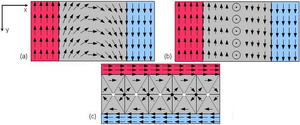Bloch wall

(the length of the vector arrows drawn should be constant.)
The Bloch wall or Bloch wall (after the Swiss-American physicist Felix Bloch ) is a transition area in ferromagnetic material between the Weiss regions below the Curie temperature , in which the orientation of the magnetic moments changes in such a way that it increases with increasing The distance (~ x) to the Weiss area are more and more twisted in the wall plane; as a result, they point exactly in the middle between the white areas not in the same direction as in the white areas (e.g. in the + y or -y direction), but in the vertical direction (~ z) .
If, on the other hand, the transition takes place in such a way that the magnetic moments also remain in the horizontal plane in the transition area, i.e. in the xy plane, then one speaks of a Néel wall . As can be seen from the compendium by A. Hubert and R. Schäfer given below, this occurs less often than the Bloch wall, except in thin layers and special situations.
description
In the first graphic, the (not shown) central vertical plane through B represents the actual plane of the Bloch wall. The magnetization here is directed upwards (M ~ z), while in areas A and C it is uniformly to the right or to the right. left shows (M ~ + y or ~ -y). The actual Bloch wall is only "roughly" defined; z. B. one can include the entire intermediate area B, with the exception of very narrow strips on the two border lines drawn, where the angular deviation from the limit value falls below a very small but finite value.
If two Weiss areas with different - mostly opposite - magnetization directions meet, this direction changes smoothly in the Bloch walls. The reason for the gradual transition lies in the energetic compromise between
- the short-range exchange energy, which aligns the spins in parallel within a Weiss region , and
- the long-range dipole-dipole interaction , which tries to align the spins antiparallel.
The magnetization remains - in contrast to the Néel wall - always parallel to the wall plane, i.e. i.e. the magnetization rotates helically . This shows the magnetization of the Bloch wall on the material surface out of the plane, and there is a magnetic stray field that z. B. can be detected via the bitter stripes .
The size of the Weiss regions (domains) is usually less than 100 µm, and the thickness of the Bloch walls is usually a few hundred atomic distances . The Bloch walls would be infinitely thick if it weren't for the energy of the magnetic anisotropy , to the square root of which the thickness of the Bloch walls is inversely proportional:
The anisotropy energy contributes because most of the spins within the Bloch wall point in heavy directions of magnetization.
Bloch walls are held in place by lattice defects , grain boundaries , inclusions or internal stresses . A hard magnetic material has a lot of lattice defects and thus greatly hinders the movement of the Bloch walls. When an external magnetic field is applied, the position of the Bloch walls changes abruptly - this is known as Barkhausen jumps .
Generalizations
Similarly, one speaks of Bloch lines or Bloch points if, starting from a line or from a point, the magnetization depends on the direction in a topologically non-trivial way. Other topological generalizations are called skyrmions .
literature
- Hans Fischer: Materials in electrical engineering. 2nd edition, Carl Hanser Verlag, Munich Vienna, 1982 ISBN 3-446-13553-7 .
- Horst Stöcker: Pocket book of physics. 4th edition, Verlag Harry Deutsch, Frankfurt am Main 2000, ISBN 3-8171-1628-4 .
- Alex Hubert and Rudolf Schäfer: Magnetic Domains , Berlin, Springer 2000, ISBN 3-540-64108-4 (very extensive compendium)
Individual evidence
- ↑ Wolfgang Bergmann: Material Technology 2: Material Production - Material Processing - Material Application . 3. Edition. Carl Hanser Verlag, Munich / Vienna 2002, p. 573 ( limited preview in Google Book search).
- ↑ W. Döring: Point Singularities in Micromagnetism ( page no longer available , search in web archives ) Info: The link was automatically marked as defective. Please check the link according to the instructions and then remove this notice. , J. Appl. Phys. 39, 1006 (1968)

